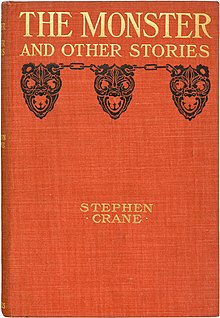 Title: The Monster
Title: The Monster
Author: Stephen Crane
Date of First Publication: 1898
Place of Publication: Harper’s Magazine
Type: Short story
Characters: None
Themes: ANDROID; RACE/POLITICS; SYMPATHETIC MONSTER
Critical Summary: Stephen Crane’s The Monster takes place in the fictional town of Whilomville, New York. The story is centered around the Trescott family; Dr. Trescott, his young son Jimmie, and their African-American coachman Henry Johnson.
There is a large emphasis on Henry’s appearance, how handsome and well-dressed he is when he takes to the street on the night of a party in the park. The festivities are short lived when the fire alarms are sounded throughout the town, and it comes to the attention of everyone that the fire has started at the home of the widely respected Dr. Trescott. The Doctor is away from home with a patient at the time the fire begins. No reason for the fire is revealed, but the spectacle draws nearly everyone from the party to their home. A neighbor, Judge Hannigan, realizes that Grace, Dr. Trescott’s wife, doesn’t know the house is on fire, and that she along with their son Jimmie are still inside. He rushes in to save them. Henry is close enough nearby to see this and runs in to assist. They rescue Grace without injury, but by the time Henry reaches Jimmie the home is engulfed in flames. Dr. Trescott returns home to this disaster. Upon finding his son and Henry are still inside, he rushes in to help. Together they save Jimmie, but not without all of them suffering burns. Henry’s injuries are so severe they pronounce him dead at the scene, though he lives with his entire face having been burned off.
All three are safely removed from the public eye and the extremity of each of their wounds is made known. All of them are alive, but it is Henry’s severe deformities that are cause for alarm according to their neighbor Judge Hannigan. It is suggested by the Judge that Henry be allowed to die a hero, his praises having been sung by everyone in their town. The town is full of ancillary characters that attempt to influence Dr. Trescott’s decision, but he refuses, nursing Henry back to health and becoming his new ward.
Henry is at first left with other families of the African-American community, under the supervision of Dr. Trescott. The Doctor pays the family a monthly stipend to have Henry stay in their homes. This fails as the superstition of the monster comes into being. The once good-looking hero of the town is now a grotesque creature that haunts their homes, scaring children and chasing away company that otherwise would come to visit. Essentially, where ever Henry wanders now he is a terror to those he encounters. The woman he was once engaged to marry is frightened of his incoherent ramblings, he is unable to articulate his wants, needs, and desires making him even more of a terror to those he meets. Eventually he becomes a permanent staple of the Trescott family, living above the horse stables. Ultimately, alienating the entire family from everyone else in Whilomville.
Dr. Trescott’s character is in the image of Victor Frankenstein in his dedication to a “monster.” The Doctor’s willingness to sacrifice his social status, his patients, and his occupation for Henry mirrors what Victor sacrifices at the hands of the Creature. There are key differences. Dr. Trescott does not create his monster. His family does not suffer death for the monster’s revenge. Dr. Trescott shows sympathy and a dedication to his “monster” that Victor never displays for his Creature. The way that the Doctor defends him throughout the story from the town and puts Henry’s needs before his own gives the reader empathy for his plight. It reflects the eloquence of the Creature, and the sympathy he inspires from the reader when he articulates his longing for companionship.
Crane addresses the racial divide through subtle social commentary with Henry. Before his reemergence as the monster he is the hero of the town. To the people of the town it would have been better for him to have died a hero, than to live as the monster. He is considered even more expendable because he is an African-American man in late 19th century. The money that is paid for his board to the first family is miniscule, and the Judge that manages the payments does not believe that his life is worth more than the few dollars offered. His disfigurement can also be understood as any deformity that could ostracize a person from what could be considered traditional society.
Administrative Notes: David Symonds, CSUF; David Sandner (editor), CSUF
